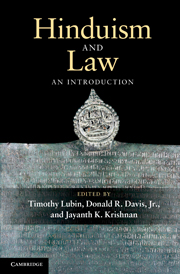Book contents
- Frontmatter
- Contents
- List of contributors
- Acknowledgements
- Chronology
- Abbreviations
- Map South Asia: political divisions c. 1860 and today
- Introduction
- Part I Hindu law
- Part II Law in ancient and medieval Hindu traditions
- Part III Law and modern Hinduism
- Chapter 12 Temples, deities, and the law
- Chapter 13 In the divine court of appeals
- Chapter 14 Contemporary caste discrimination and affirmative action
- Chapter 15 Law and Hindu nationalist movements
- Chapter 16 Legally and politically layered identities
- Glossary
- Bibliography
- Index
Chapter 12 - Temples, deities, and the law
Published online by Cambridge University Press: 05 June 2012
- Frontmatter
- Contents
- List of contributors
- Acknowledgements
- Chronology
- Abbreviations
- Map South Asia: political divisions c. 1860 and today
- Introduction
- Part I Hindu law
- Part II Law in ancient and medieval Hindu traditions
- Part III Law and modern Hinduism
- Chapter 12 Temples, deities, and the law
- Chapter 13 In the divine court of appeals
- Chapter 14 Contemporary caste discrimination and affirmative action
- Chapter 15 Law and Hindu nationalist movements
- Chapter 16 Legally and politically layered identities
- Glossary
- Bibliography
- Index
Summary
“Sueing Shiva Dismays Dealers,” read the headline in the Sunday Times of London, February 21, 1988. The Hindu god Śiva, it appeared, had come to the old imperial capital to bring a suit before the Queen’s Bench for the return of his stolen property. It seemed to be a classic man-bites-dog story, and the Times reporter Alison Beckett emphasized the exotic quality of the court case.
The case was a bizarre enough event in itself. It was brought by the God Shiva against the Metropolitan Police and the Bumper Development Corporation of Alberta, Canada, for the return of an eleventh century bronze dancing figure of the god. Since he could not actually appear, Shiva was represented by the Indian government and, on paper, by the Shiva Lingam, a cylindrical stone phallus, the deity’s main physical manifestation in any Shiva temple – although the phallus was not produced in court.
(Beckett 1988: 9C)The object in question, the Pathur Naṭarāja, had been accidentally dug up in 1976 in a small hamlet in southern India by a landless laborer, sold to a local buyer for about Rs. 200 (about US$15 at the exchange rate of the time), and then transmitted through an underground network of clandestine antiquities dealers until it reached London. There a Canadian businessman and art collector, Robert Borden, purchased the Naṭarāja for something around £250,000. Before the image went on to Canada, however, it was sent over to the British Museum for cleaning. There, suspicions were raised that the Naṭarāja was in fact a stolen art object, and Scotland Yard impounded the Pathur Naṭarāja.
At this point, Borden’s firm issued a writ for return of the sculpture, on the grounds that he had purchased it in good faith. The Indian government then joined in with a counterclaim. The Union of India alleged that the Naṭarāja that Borden had purchased was in fact one stolen from Pathur and illegally smuggled to London. They became the plaintiff seeking return of stolen property, while the Bumper Corporation headed by Borden was the defendant seeking to maintain possession of it. But there was a legal problem here. Did the Indian government in fact have any legal claim to this object? Here is where the god Śiva entered into the case. He would appear as the former “owner” of his own property, namely the Naṭarāja icon depicting one of his many manifest forms, and act as plaintiff, with the Indian government serving only as “technical plaintiff.” The Indian case identified Śiva as a “juristic personality” who could own property and seek its lawful return when expropriated. And with the decision of Justice Anthony Kennedy, Śiva’s claim was affirmed.
- Type
- Chapter
- Information
- Hinduism and LawAn Introduction, pp. 195 - 206Publisher: Cambridge University PressPrint publication year: 2010
- 1
- Cited by



